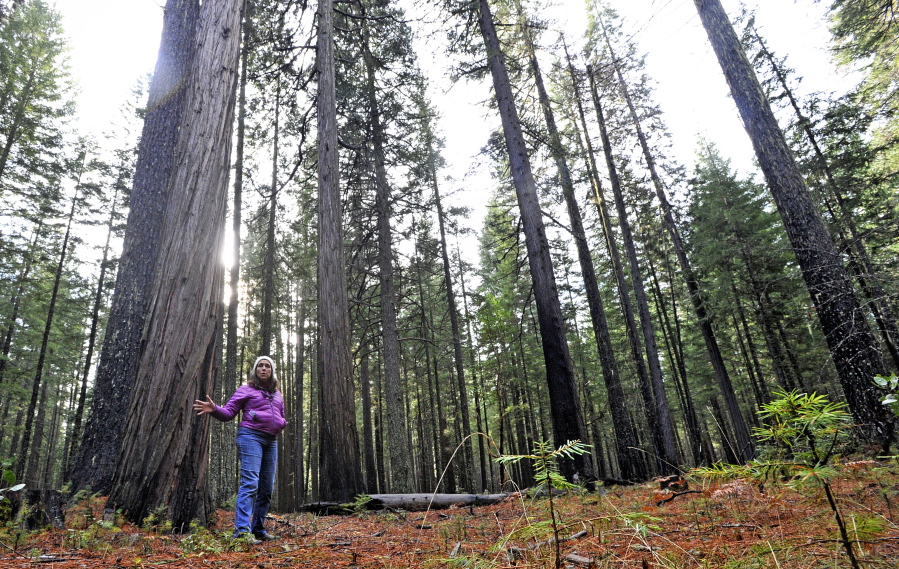UNION CREEK, Ore. — The 10-mile ribbon of Highway 62 as it shoots through the Rogue River-Siskiyou National Forest between Prospect and Union Creek has the viewscapes that make tree-lovers and city-dwellers all wish they had moon roofs.
Massive sugar and Ponderosa pines, some of them more than 300 years old, reach skyward almost in unison with the highway that’s parted the forest for wide-eyed travelers for more than a century.
“It’s a pretty marvelous place,” said Ellen Goheen, a Forest Service plant pathologist. “Everybody’s driven that road. Everybody’s shown visitors those trees.”
But a deeper look sideways into the corridor reveals a densely overgrown forest that is killing the big pines, one dead treetop at a time.
Thick patches of smaller Douglas fir are overcrowding the legacy pines, allowing bark beetles to run roughshod on the old trunks and helping nasty root-rot diseases creep through the soil.
“When you drive through, what you’re seeing is the trunk of the trees, not so much of what’s going on on top,” Goheen said. “People don’t realize that some of what they see is dead.”
The Forest Service hopes to reverse that trend with its Big Pines Project, a new approach using a combination of controlled fire and chainsaws to reclaim stands for the biggest, oldest trees.
The agency proposes treating 756 acres of stands within a quarter-mile of the corridor, including the commercial logging of about 6 million board feet of the smaller competition trees in 11 different units. It then plans to use controlled burns on the entire project area to return the forest to its historically open, multi-canopied stands.
Forest officials believe the end result will reduce beetles’ capabilities to gang up on the big but weakened pines and reduce the number of smaller firs and other species more susceptible to root-rot and, therefore, slow its reaper-like creep through the forest.
“There are a whole lot of little trees that will never become big trees,” said Shannon Downey, who is overseeing the project studies. “It takes a long time to grow a 300-year-old tree. We don’t want to lose them.”
The environmental assessment on the proposal is expected to be out for public review in early January, with a final decision on the project likely in the spring, Downey said.
Timber could be offered for sale as early as summer, said Mike Coggin, silviculturist at the forest’s High Cascades Ranger District based at Prospect.
The proposals, which were floated earlier this fall, are finding a warm reception among at least some members of the environmental community who also want to enhance the forest with the oldest trees in mind.
“That makes a ton of sense to us, get these legacy trees some breathing room and a chance to stick around longer,” said Executive Director Joseph Vaile of the Klamath-Siskiyou Wildlands Center. “When you have a 500-year-old tree, it takes more than a little effort to keep them around.”
Vaile said his group’s main concerns are impacts to old-growth trees, so he’s glad the Forest Service plans to log only the smaller trees to help them.
“We’re really appreciative of what they’re doing up there,” Vaile said. “It’s a really special spot for Southwest Oregon.”
The unique nature of these gigantic trees has been well established in Southern Oregon science and lore. The strip within a quarter-mile on each side of the highway holds state and federal protections as a scenic corridor, where the regular cut-and-plant timber rotations allowed elsewhere in the forest are banned and activities are limited to protecting and enhancing this viewshed and its wildlife.
The ranger district is packed with historical photos of Model Ts slithering among monolithic trees en route to Crater Lake National Park. Routing and paving of the current Highway 62 in the 1920s and ’30s featured pullouts so travelers could marvel at the trees, including a nearly 8-foot-diameter Mammoth pine. The tree succumbed to a beetle infestation in the 1960s, but its fallen trunk and stump remain today, according to the Forest Service.
What those historical photos show, however, is a floor density much more sparse than in recent decades as big sugar pine after big sugar pine lost battles with beetles uniquely set up to take these giants down.
A few beetles find a stressed tree and they send out pheromones that attract hordes of beetles, Downey said. Studies show, however, that a 5 mph breeze is enough to disrupt the beetles’ calls to action.
“On a nice day you’re not going to get a breeze next to the bole of that tree,” Downey said as she perused the project area.
The alarm really sounded in 1997, when Goheen and other plant pathologists studying the area determined that the health issues surrounding the encroaching forest would create a die-off in which only a few big sugar pines would be left in 40 to 50 years.
That led to the first intervention about a decade ago when crews cleared smaller trees and brush around 90 of the larger sugar pines within the corridor, Goheen said.
The Big Pines Project as proposed, however, is the largest such treatment ever done within the corridor for pine protection, Downey said. Its largest unit is 412 acres near Natural Bridge that includes some historical but currently unused northern spotted owl habitat. There are no known spotted owls within the project area, she said.
Individuals and clumps of trees will be retained and commercial thinning will help create new clearings where new sugar pines can be planted, Downey said.
“This is a demonstration project and we plan to extend it to other areas within the scenic corridor where appropriate,” Downey said.



